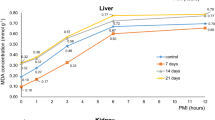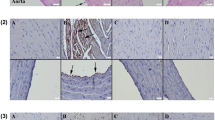Abstract
Cardiac ischemia reperfusion leads to oxidative stress and poor physiological recovery. Selenium deficiency down-regulates thioredoxin reductase (Txnrd) and glutathione peroxidase (Gpx) activity, impairing recovery from ischemia-reperfusion. Furthermore, selenium supplementation has been shown to be cardioprotective and lessens oxidative stress in reperfused rat hearts. In this study we have investigated the role of selenium in the mRNA expression of these, and related antioxidant proteins, post ischemia-reperfusion. Male rats were fed varying doses of selenium for five weeks. Hearts were isolated and perfused using the Langendorff method with 22.5 min of global ischemia and 45 min reperfusion. RNA was extracted for quantitative real-time PCR analysis of glutathione peroxidase (Gpx)-1 and 4, glutathione reductase (Gsr), thioredoxin peroxidase-2 (Prdx2), thioredoxin (Txn) and thioredoxin reductase (Txnrd)-1 and 2 gene expression. Selenium deficiency produced significant reductions in Gpx-1, Gpx-4, Prdx2, Txnrd-1 and Txnrd-2 expression. Conversely, selenium supplementation of 1000 μg/kg significantly up-regulated Gpx-1, Gpx-4, Txn, Txnrd-1 and Txnrd-2 transcription. Our results show selenium modulates the cardiac mRNA expression of thioredoxin and glutathione related enzymes post ischemia-reperfusion, and impacts on tolerance to ischemia-reperfusion. (Mol Cell Biochem 270: 131–138, 2005)
Similar content being viewed by others
References
Kloner R, Przyklenk K, Whittaker P: Deleterious effects of oxygen radicals in ischemia/reperfusion. Circ 80: 1115–1127, 1989
McCord J: Oxygen-derived free radicals in postischemic tissue injury. New Eng J Med 312: 159–163, 1985
Venardos K, Harrison G, Headrick J, Perkins A: Effects of dietary selenium on glutathione peroxidase and thioredoxin reductase activity and recovery from cardiac ischemia-reperfusion. J Trace Elem Med Biol 18: 81–88, 2004
Toufektsian M-C, Boucher F, Pucheu S, Tanguy S, Ribout C, Sanou D, Tresallet N, de Leiris J: Effects of selenium deficiency on the response of cardiac tissue to ischemia and reperfusion. Toxicol 148: 125–132, 2000
Polronieri R, Cevese A, Sbarbati A: Protective effect of selenium in cardiac ischemia and reperfusion. Cardioscience 3: 155–160, 1992
Weiss S, Evenson J, Thompson K, Sunde R: Dietary selenium regulation of glutathione peroxidase mRNA and other selenium-dependent parameters in male rats. J Nutr Biochem 8: 85–91, 1997
Hadley K, Sunde R: Selenium regulation of thioredoxin reductase activity and mRNA levels in rat liver. J Nutr Biochem 12: 693–702, 2001
Liu D, Liu S, Huang Y, Liu Y, Zhang Z, Han L: Effect of selenium on human myocardial glutathione peroxidase gene expression. Chin Med J (Engl) 113: 771–775, 2000
Peirson S, Butler J, Foster R: Experimental validation of novel and conventional approaches to quantitative real-time PCR data analysis. Nucleic Acids Res 31(14): e73, 2003
Ashton K, Holmgren K, Peart J, Lankford A, Matherne G, Grimmond S, Headrick J: Effects of A1 adenosine receptor overexpression on normoxic and post-ischemic gene expression. Cardiovasc Res 57: 715–726, 2003
Dak D, Engelman R, KimuraY: Molecular adaptation of cellular defences following preconditioning of the heart by repeated ischemia. Cardiovasc Res 27: 578–584, 1993
Allan C, Lacourciere G, Stadtman T: Responsiveness of selenoproteins to dietary selenium. Annu Rev Nutr 19: 1–16, 1999
Keshan Disease Research Group: Epidemiologic studies on the etiologic relationship of selenium and Keshan disease. Chin Med 83: 546–550, 1979
Korpela H: Hepatic selenium concentrations in pigs with microangioplasty (mulberry heart disease) – an animal model for the study of oxidative damage. Int J Vitam Nutr Res 60: 156–158, 1990
Husbeck B, Berggren M, Powis G: DNA microarray reveals increased expression of thioredoxin peroxidase in thioredoxin-1 transfected cells and its functional consequences. Adv Exp Med Biol 500: 157–168, 2000
Arner E, Holmgren A: Physiological functions of thioredoxin and thioredoxin reductase. Eur J Biochem 267: 6102–6109, 2000
Gross M, Oertel M, Kohrle J: Differential selenium-dependent expression of type I 5′-deiodinase and glutathione peroxidase in the porcine epithelial cell line LLC-PK1. Biochem J 306: 851–856, 1995
Bermano G, Arthur J, Hesketh J: Selective control of cytosolic glutathione peroxidase and phospholipid hydroperoxide glutathione peroxidase mRNA stability by selenium supply. FEBS Lett 387: 157–160, 1996
Jameson R, Carlson B, Butz M, Esser K, Hatfield D, Diamond A: Selenium influences the turnover of selenocysteine tRNA[Ser]Sec chinese hamster ovary cells. J Nutr 132: 1830–1835, 1992
Author information
Authors and Affiliations
Corresponding author
Rights and permissions
About this article
Cite this article
Venardos, K., Ashton, K., Headrick, J. et al. Effects of dietary selenium on post-ischemic expression of antioxidant mRNA. Mol Cell Biochem 270, 131–138 (2005). https://doi.org/10.1007/s11010-005-5279-y
Received:
Accepted:
Issue Date:
DOI: https://doi.org/10.1007/s11010-005-5279-y




